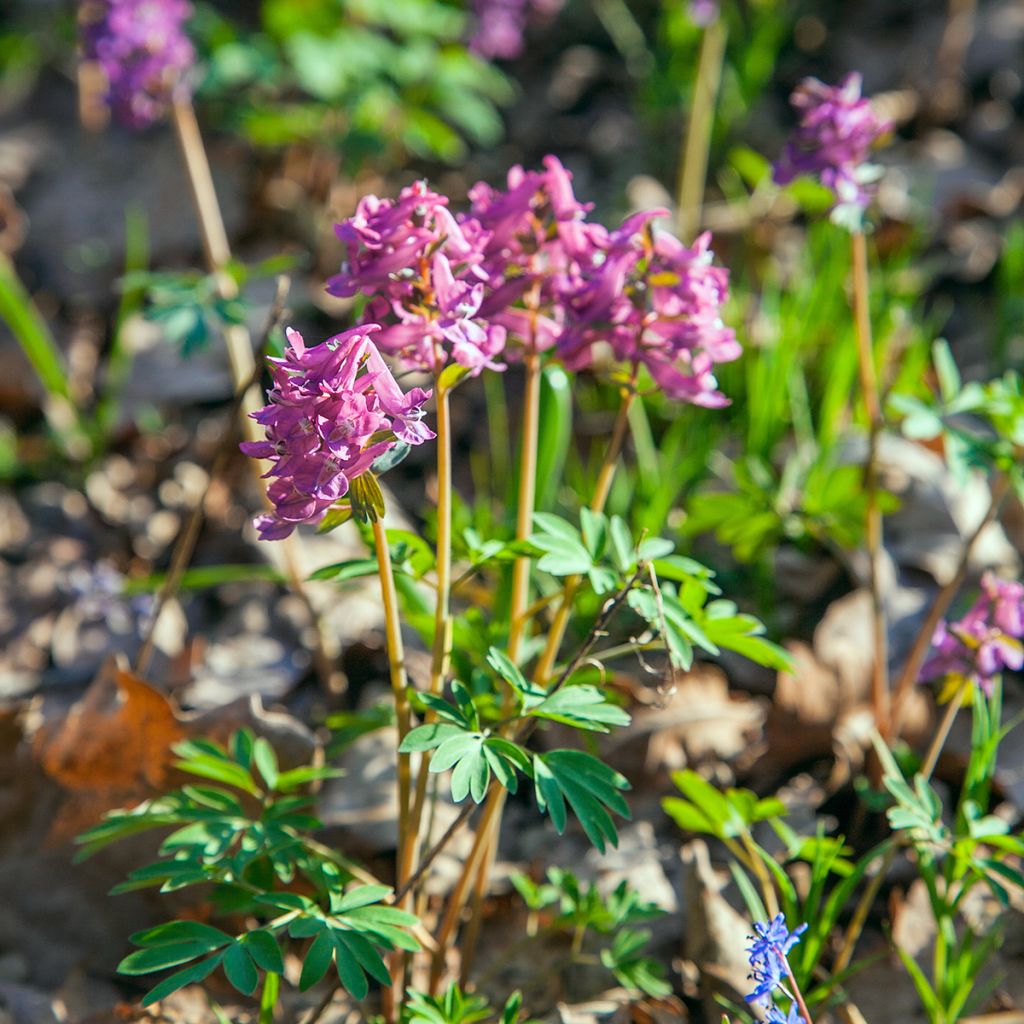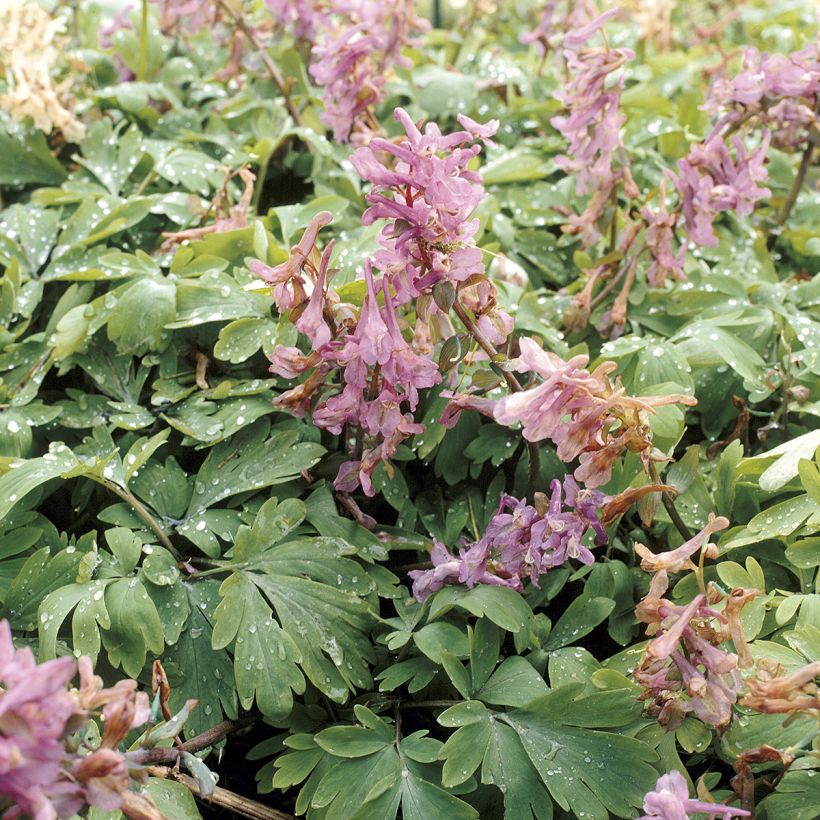

Corydalis solida ssp. solida


Corydalis solida ssp. solida


Corydalis solida ssp. solida


Corydalis solida ssp. solida
Corydalis solida ssp. solida
Corydalis solida ssp. solida
Fumewort, Solid-rooted fumewort, Bird in a bush
This plant carries a 6 months recovery warranty
More information
We guarantee the quality of our plants for a full growing cycle, and will replace at our expense any plant that fails to recover under normal climatic and planting conditions.
From €5.90 for pickup delivery and €6.90 for home delivery
Express home delivery from €8.90.
Does this plant fit my garden?
Set up your Plantfit profile →
Description
Corydalis solida is a small perennial and bulbous plant that forms a spreading carpet, charming with its early spring flowering. Clusters of lilac-pink or purple-pink flowers rise above the delicately crafted foliage. The vegetation then disappears in summer, allowing the bulbs to recover and spread, forming larger patches each year. Easy to grow in ordinary to limestone soil, this plant appreciates partial shade and even grows in full shade.
Corydalis solida is a small bulbous plant native to central and southern Europe, and can be found as far as western Russia. It grows in shady meadows, woods, and coppices, as well as in mountain and subalpine meadows, in limestone soil. Corydalis belongs to the Papaveraceae family (like the poppy).
It can rival horticultural selections in beauty. With a low habit, it forms floral spikes in March and April, about 20cm (8in) tall, emerging from a carpet of leaves. They bear from a dozen to twenty small flowers with short peduncles, forming a cluster. The floral corollas are made up of 4 fused petals forming a long tube that opens into a trumpet at its end, with 2 petals gracefully arching upwards and the other 2 downwards, thus revealing the pistil and stamens. The flower's throat is whitish while the long and slender tube takes on a beautiful pink-purple hue. These clusters of flowers stand erect above the mass of foliage, which serves as their backdrop with its matte green colour. The leaves are doubly, sometimes even triply, dissected, and their shape is reminiscent of columbine leaves, even though they do not belong to the same family. The flowering is followed by the formation of elongated capsule fruits resembling siliques (a characteristic of the cabbage family and some Papaveraceae). Corydalis solida is hermaphroditic and entomophilous (its pollination is done by insects). The above-ground part disappears in summer, while the bulb replenishes its reserves.
Corydalis solida is ideal for filling the understory or carpeting the ground on the edge of trees. It naturalises easily over the years, coexisting well with other later flowering plants since it disappears in the summer. In neutral soil, it can share the space with Dicentra 'Pink Diamonds', a variety of Bleeding Heart with pink flowers that bloom from June on elegant grey-green cut foliage. Fairy Wings will also be perfect companions, such as Epimedium grandiflorum 'Purple Pixie', with its surprising cross-shaped flowers blending purple-pink and cream-white. Appearing in May, they will take over from your corydalis. Beautiful Japanese anemones will extend the flowering season from August to October with their single to double flowers in white, pink, and purple, enhanced with a yellow centre. Corydalis also performs well in pots and creates a beautiful effect in hanging baskets from which it cascades. Plant this corydalis above retaining walls, in cool regions, or in shady rockeries.
Report an error about the product description
Corydalis solida ssp. solida in pictures




Plant habit
Flowering
Foliage
Botanical data
Corydalis
solida ssp. solida
Fumariaceae - Papaveraceae
Fumewort, Solid-rooted fumewort, Bird in a bush
Central Europe
Planting and care
Ideally, plant Corydalis solida in partial shade, or even in full shade, in well-draining and moderately fertile soil. It tolerates the presence of limestone and clay in the soil, and also appreciates a bit of humus. This young plant prefers soils that remain moist, even in summer, especially if it is exposed to (moderate) sunlight. It is easily cultivated in most of our regions. Downy mildew and rust can develop if the atmosphere or soil is too dry. Aphids and gastropods attack this plant.
Planting period
Intended location
Care
This item has not been reviewed yet - be the first to leave a review about it.
Haven't found what you were looking for?
Hardiness is the lowest winter temperature a plant can endure without suffering serious damage or even dying. However, hardiness is affected by location (a sheltered area, such as a patio), protection (winter cover) and soil type (hardiness is improved by well-drained soil).

Photo Sharing Terms & Conditions
In order to encourage gardeners to interact and share their experiences, Promesse de fleurs offers various media enabling content to be uploaded onto its Site - in particular via the ‘Photo sharing’ module.
The User agrees to refrain from:
- Posting any content that is illegal, prejudicial, insulting, racist, inciteful to hatred, revisionist, contrary to public decency, that infringes on privacy or on the privacy rights of third parties, in particular the publicity rights of persons and goods, intellectual property rights, or the right to privacy.
- Submitting content on behalf of a third party;
- Impersonate the identity of a third party and/or publish any personal information about a third party;
In general, the User undertakes to refrain from any unethical behaviour.
All Content (in particular text, comments, files, images, photos, videos, creative works, etc.), which may be subject to property or intellectual property rights, image or other private rights, shall remain the property of the User, subject to the limited rights granted by the terms of the licence granted by Promesse de fleurs as stated below. Users are at liberty to publish or not to publish such Content on the Site, notably via the ‘Photo Sharing’ facility, and accept that this Content shall be made public and freely accessible, notably on the Internet.
Users further acknowledge, undertake to have ,and guarantee that they hold all necessary rights and permissions to publish such material on the Site, in particular with regard to the legislation in force pertaining to any privacy, property, intellectual property, image, or contractual rights, or rights of any other nature. By publishing such Content on the Site, Users acknowledge accepting full liability as publishers of the Content within the meaning of the law, and grant Promesse de fleurs, free of charge, an inclusive, worldwide licence for the said Content for the entire duration of its publication, including all reproduction, representation, up/downloading, displaying, performing, transmission, and storage rights.
Users also grant permission for their name to be linked to the Content and accept that this link may not always be made available.
By engaging in posting material, Users consent to their Content becoming automatically accessible on the Internet, in particular on other sites and/or blogs and/or web pages of the Promesse de fleurs site, including in particular social pages and the Promesse de fleurs catalogue.
Users may secure the removal of entrusted content free of charge by issuing a simple request via our contact form.
The flowering period indicated on our website applies to countries and regions located in USDA zone 8 (France, the United Kingdom, Ireland, the Netherlands, etc.)
It will vary according to where you live:
- In zones 9 to 10 (Italy, Spain, Greece, etc.), flowering will occur about 2 to 4 weeks earlier.
- In zones 6 to 7 (Germany, Poland, Slovenia, and lower mountainous regions), flowering will be delayed by 2 to 3 weeks.
- In zone 5 (Central Europe, Scandinavia), blooming will be delayed by 3 to 5 weeks.
In temperate climates, pruning of spring-flowering shrubs (forsythia, spireas, etc.) should be done just after flowering.
Pruning of summer-flowering shrubs (Indian Lilac, Perovskia, etc.) can be done in winter or spring.
In cold regions as well as with frost-sensitive plants, avoid pruning too early when severe frosts may still occur.
The planting period indicated on our website applies to countries and regions located in USDA zone 8 (France, United Kingdom, Ireland, Netherlands).
It will vary according to where you live:
- In Mediterranean zones (Marseille, Madrid, Milan, etc.), autumn and winter are the best planting periods.
- In continental zones (Strasbourg, Munich, Vienna, etc.), delay planting by 2 to 3 weeks in spring and bring it forward by 2 to 4 weeks in autumn.
- In mountainous regions (the Alps, Pyrenees, Carpathians, etc.), it is best to plant in late spring (May-June) or late summer (August-September).
The harvesting period indicated on our website applies to countries and regions in USDA zone 8 (France, England, Ireland, the Netherlands).
In colder areas (Scandinavia, Poland, Austria...) fruit and vegetable harvests are likely to be delayed by 3-4 weeks.
In warmer areas (Italy, Spain, Greece, etc.), harvesting will probably take place earlier, depending on weather conditions.
The sowing periods indicated on our website apply to countries and regions within USDA Zone 8 (France, UK, Ireland, Netherlands).
In colder areas (Scandinavia, Poland, Austria...), delay any outdoor sowing by 3-4 weeks, or sow under glass.
In warmer climes (Italy, Spain, Greece, etc.), bring outdoor sowing forward by a few weeks.


































